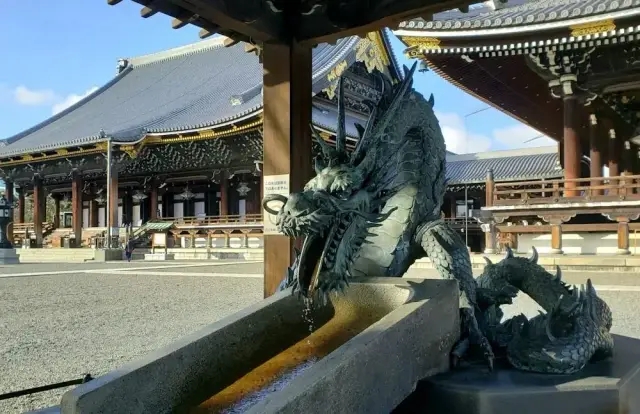https://www.dekitabi.com/itinerary/kyoto-station-area-tour
Kyoto, the ancient capital of Japan, is renowned for its rich cultural heritage, stunning temples, and unique blend of traditional and modern experiences. Among the city’s many treasures are To-ji Temple, Nishi Hongan-ji Temple, Higashi Hongan-ji Temple, the tea ceremony at Ju-an, and the iconic Kyoto Tower. Each site offers a distinct glimpse into Kyoto’s storied past and vibrant present. Let’s embark on a journey to explore these remarkable locations.
To-ji Temple: A Legacy of Architectural Grandeur

https://www.dekitabi.com/attraction/to-ji-temple
To-ji Temple, or Kyo-o-gokoku-ji, stands as a testament to the grandeur of Japanese architecture and Buddhist tradition. Founded in the early 9th century by Emperor Kammu, To-ji is renowned for its five-story pagoda, the tallest wooden structure in Japan, reaching a height of 54.8 meters. This pagoda, a UNESCO World Heritage Site, is not only an architectural marvel but also a symbol of Kyoto’s historical and spiritual significance.
The temple’s grounds are expansive, featuring beautiful gardens, serene ponds, and various halls, including the Kondo (Main Hall) and the Kodo (Lecture Hall). The Kondo houses a collection of important statues and artifacts, including a revered statue of the Buddha. The Kodo, with its intricate woodwork and traditional design, serves as a space for scholarly activities and ceremonies.
To-ji Temple also hosts a bustling flea market on the 21st of each month, known as the Kōbō-san Market, named after the temple’s founder, Kōbō Daishi. The market is a vibrant mix of antique shops, craft stalls, and food vendors, offering visitors a chance to experience local culture and pick up unique souvenirs.
Nishi Hongan-ji Temple: A Pillar of Pure Land Buddhism

https://www.dekitabi.com/attraction/nishi-hongan-ji
Nishi Hongan-ji Temple is one of the two principal Hongan-ji temples and a major center of the Jodo Shinshu school of Pure Land Buddhism. Established in the 13th century, this temple has played a significant role in the development and propagation of Pure Land teachings.
The temple complex is vast, with a number of impressive structures, including the main hall, known as the Goei-do. This hall is renowned for its stunning architecture and the intricate craftsmanship of its wooden interiors. The temple’s grandeur is further highlighted by the spacious courtyard and beautifully maintained gardens.
Nishi Hongan-ji is also known for its detailed architectural style, characterized by the use of elaborate wooden carvings and distinctive rooflines. The temple’s cultural importance is underscored by its status as a UNESCO World Heritage Site, recognized for its historical and architectural significance.
Higashi Hongan-ji Temple: A Spiritual Sanctuary

https://www.dekitabi.com/attraction/higashi-hongan-ji
Higashi Hongan-ji Temple, the other principal Hongan-ji temple, complements its counterpart with its own unique history and spiritual ambiance. Founded in the early 17th century, this temple serves as the head temple of the Otani branch of Jodo Shinshu Buddhism.
The temple’s grounds are equally impressive, featuring the vast Shosei-en Garden, known for its seasonal beauty and tranquil atmosphere. The main hall, known as the Goei-do, is adorned with intricate woodwork and showcases the temple’s grandeur. Visitors can also explore the various sub-temples and halls within the complex, each offering insights into the rich traditions of Jodo Shinshu Buddhism.
Higashi Hongan-ji is particularly noted for its large-scale wooden structure, which reflects the temple’s historical significance and its role in the development of Pure Land Buddhism. The temple’s serene environment and its extensive gardens provide a peaceful retreat from the bustling city.
Tea Ceremony at Ju-an: A Moment of Tranquility

https://www.dekitabi.com/attraction/tea-ceremony-juan
No visit to Kyoto would be complete without experiencing the traditional Japanese tea ceremony, and Ju-an offers a perfect setting for this timeless ritual. Located in the heart of Kyoto, Ju-an is a traditional tea house that provides an authentic tea ceremony experience, allowing visitors to immerse themselves in this elegant and meditative practice.
The tea ceremony, or “chanoyu,” is an art form that emphasizes harmony, respect, purity, and tranquility. At Ju-an, guests are guided through the meticulous process of preparing and enjoying matcha (powdered green tea) in a serene and beautifully arranged setting. The ceremony is a reflection of Japanese aesthetics and mindfulness, offering a deep connection to the cultural and spiritual aspects of tea.
Ju-an’s tea ceremony is conducted in a traditional tatami-matted room, with participants seated on the floor, which enhances the sense of connection to the ritual. The ceremony includes the careful preparation of the tea, the artful presentation of sweets, and the quiet contemplation that accompanies the enjoyment of the tea.
Kyoto Tower: A Modern Icon with a View

https://www.dekitabi.com/attraction/kyoto-tower
Rising above Kyoto’s historic landscape, Kyoto Tower offers a contemporary contrast to the city’s ancient temples and traditional experiences. Completed in 1964, the tower stands at 131 meters tall and provides a panoramic view of Kyoto and its surrounding areas from its observation deck.
The tower’s design is sleek and modern, with a distinctive cylindrical shape and a glass-enclosed observation deck that offers breathtaking views of the city. On clear days, visitors can see as far as the distant mountains and get a unique perspective on Kyoto’s blend of old and new.
Kyoto Tower also features various dining and shopping options, allowing visitors to enjoy a meal or shop for souvenirs while taking in the impressive views. The tower’s illuminated exterior at night adds to the city’s nighttime charm, making it a striking landmark in the Kyoto skyline.
Conclusion
Kyoto’s rich tapestry of cultural, historical, and modern attractions offers a diverse range of experiences for visitors. From the architectural splendor of To-ji Temple to the spiritual depth of Nishi and Higashi Hongan-ji Temples, the tranquil tea ceremony at Ju-an, and the modern marvel of Kyoto Tower, each site contributes to the city’s unique charm and historical significance. Whether you are exploring ancient temples or enjoying contemporary views, Kyoto provides an unforgettable journey through Japan’s heritage and modernity.


Leave a Reply